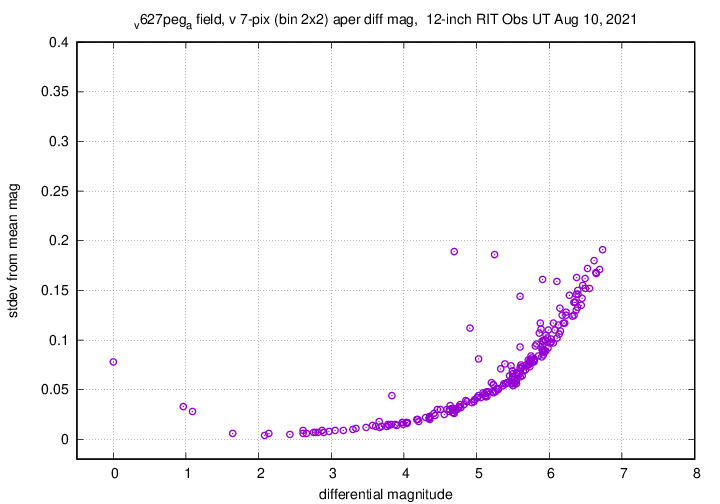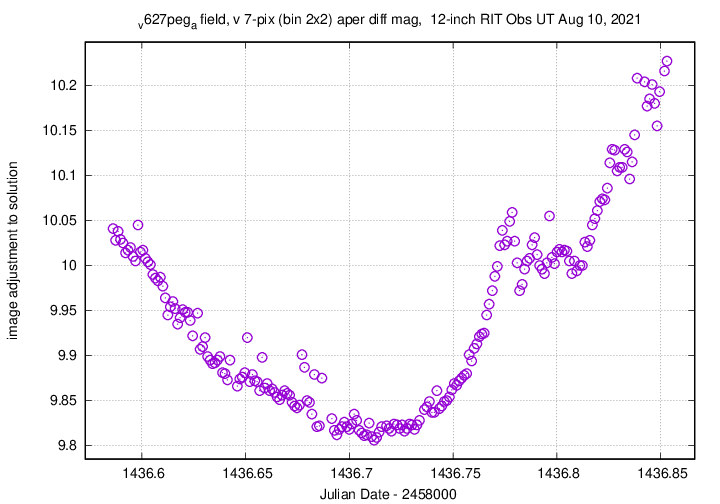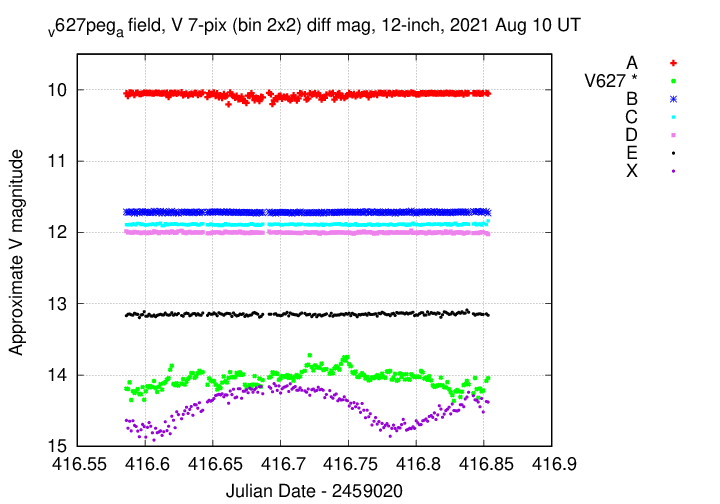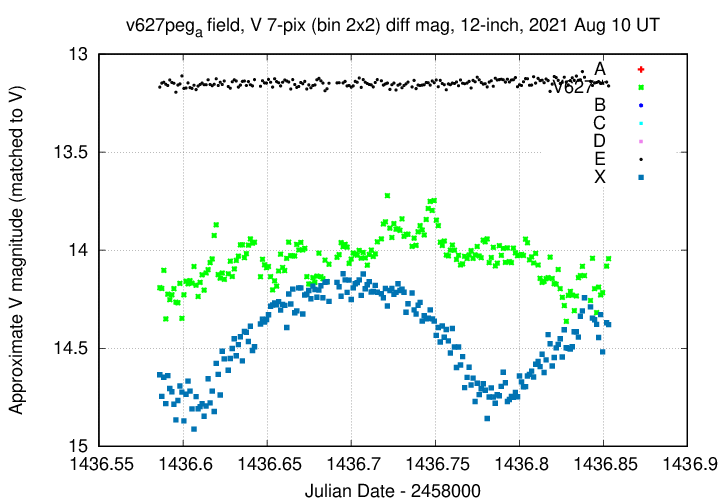
On the night of Aug 09/10, 2021, under fair conditions, I acquired images of the cataclysmic variable star V627 Peg. One can find information about it at
The sky was hazy, but not too bad. The real problem tonight was that I forgot to acquire the longer dark frames I needed for tonight's images ...
Note added 8/11/2021: I have since acquired proper 90-second dark frames at T = -11 C, and used them to re-reduce the measurements of V627 Peg. The data shown below are the revised versions. Only minor differences, but slightly less noisy.
Christian Knigge is soliciting observations of this cataclysmic variable star at all wavelengths. The AAVSO has advertised for optical measurements, and I'm joining the effort.
The main setup was:
Notes from the night:
... and then forgot and went home. By the time I realized this, it was noon, and the temperature had risen so far that I couldn't cool the camera down to -11 C again.
The result: I used 30-second darks instead of the proper 90-second darks to reduce the images. There were plenty of hot pixels visible in the "cleaned" images, but I had no choice but to measure them anyway. The bottom line is increased noise in the measurements. Sigh.
Note added 8/11/2021: I have now acquired proper 90-second darks at T = -11 C, and used them to re-analyze the original images. Results below are based on the re-analysis.
The object is located at
RA = 21:38:06.63 Dec = +26:19:56.0 (J2000)
A chart of the field is shown below. The size of the chart is about 31 x 26 arcminutes.

I've marked the location of several comparison stars as well. See
I'll use star "D" to shift my instrumental magnitudes to the V-band scale. It has a V-band magnitude (according to AAVSO chart X26768AQ) of 12.002, and (B-V) = 0.692.
The star marked "X" is an eclipsing binary of type EW, with a period of 0.36 days and amplitude of about +/- 0.3 mag in V-band.
I took a photo of the finder TV's screen when pointing to this target; this could be a useful reference for the future:

The sky value shows basically clear skies, with very minor brief increases.

The FWHM graph below shows only a small amount of drift during the night.

Using aperture photometry with a radius of 7 pixels in a V filter (binned 2x2, each pixel is 1.24 arcsec, so a radius of 8.7 arcsec), I measured the instrumental magnitudes of a number of reference stars and the target. Following the procedures outlined by Kent Honeycutt's article on inhomogeneous ensemble photometry, I used all stars available in each image to define a reference frame, and measured each star against this frame.
Sigma-vs-mag plots show that the floor was about 0.006 mag after I removed a few images with large outliers. Note the very large scatter in the faint stars, due to the improper dark subtraction.
This is the re-reduced version with proper dark frame.

The change in zeropoint shows only a few outliers.
This is the re-reduced version with proper dark frame.

Here is the light curve of the object and several field stars in the V filter; I've shifted the instrumental magnitudes so that star "D" = 000-BJV-433 on AAVSO chart X26767AK has the value given by AAVSO as its V-band magnitude.
This is the re-reduced version with proper dark frame.

Here's a closeup, also showing the light curve of star "X", the EW variable just south of the target.
This is the re-reduced version with proper dark frame.

I have submitted these measurements to the AAVSO, CBA, and VSNet.
You can download my measurements below. A copy of the header of the file is shown to explain the format.
This is the re-reduced version with proper dark frame.
# Measurements of V627Peg made at RIT Obs, UT 2021 Aug 10, # in fair conditions (haze), # by Michael Richmond, # using Meade 12-inch LX200 and ATIK 11000. # Exposures 90 seconds long, V filter. # Tabulated times are midexposure (FITS header time - half exposure length) # and accurate only to +/- 1 second (??). # 'mag' is a differential magnitude based on ensemble photometry # using a circular aperture of radius 7 pix = 8.8 arcseconds. # which has been shifted so AAVSO 000-BJV-433 has mag=12.002 # which is its V-band magnitude according to AAVSO chart X26767AK. # # UT_day JD HJD mag uncert Aug10.08615 2459436.58615 2459436.59049 14.191 0.049 Aug10.08734 2459436.58734 2459436.59168 14.195 0.048 Aug10.08854 2459436.58854 2459436.59288 14.102 0.047
Last modified 8/11/2021 by MWR.